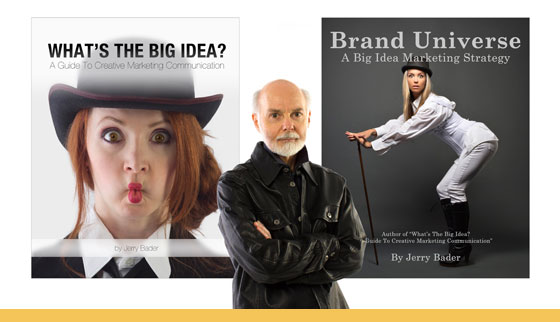“Our cognitive hubris allows us to think that we’re smarter than we actually are, to stubbornly deny the overwhelming evidence that human cognition is in fact a messy subjective mix of facts and feelings, intellect and instinct, reason and gut reaction. Pure, objective, analytical ‘just-the-facts’ Cartesian reason is a wonderful goal – ‘God’s crowning gift to man’ as Sophocles put it – but it’s an unachievable myth. And believing in it is dangerous. …”
– David Ropeik, “Big Think,” Dealing With the Danger of Cognitive Hubris
People are sick and tired of advertising. It invades every aspect of our lives and most of it is wasted and pointless. You cannot expect to know how to use a tool if you do not know what that tool is used to accomplish: you wouldn’t try to use a hammer to install a screw, but that is just what most companies do when it comes to advertising.
People Are Sick and Tired of Advertising
Advertising. Promotion. Brand. Marketing. The reason we have four words is because each one describes something different. Advertising is the process of delivering a message; it can take the form of a branding message or a promotional message. It is a tactical decision of how and where to communicate. Promotion is a time-limited price-related message used to drive sales or counteract competitive advantage. Brand is the space you own in your audience’s mind so that they associate you with particular psychological, social, and behavioral desires. And marketing is the process of embedding a brand personality in the audience’s collective mind so that your offering becomes synonymous with your brand and when your audience is confronted with a choice, your brand comes to mind first; four words with very different meanings and functions.
High Tech Supremacy
We live in an age of high tech supremacy; it controls every aspect of our lives: work, play, and even social interaction including at times, for those inclined, the bedroom. We love our gadgets.
In the 1967 movie, “The Graduate” Dustin Hoffman plays a young college graduate. His parents hold a graduation party and invite friends, family, and neighbors all prepared to demand what’s next for the young graduate or to give him advice on a career path. One guest puts his arm around Dustin and says, “I want to say one word to you, just one word. Are you listening? …Plastics.” Today that word is technology. New technologies are coming on the scene as fast as Mrs. Robinson came-on to Dustin Hoffman, you remember Mrs. Robinson, don’t you? But technology is merely a tool, a means to accomplish something and not an accomplishment in and of itself; at least for everybody but the inventor who’s goal is to strike it rich with a lucrative IPO. The rest of us just want to use the high tech gizmo to build something.
Meaningful Messaging
So when it comes to discussions of marketing, isn’t it time we changed our focus from tech-envy to meaningful messaging? To that end we’ve embarked on a mission to create a series of e-books that guide the online entrepreneur through the maze of conflicting media hype and provide the psychological tools to build a brand and a business that meets your expectations and dreams.
Tools To Build and Sustain A Marketing Strategy
Our first e-book “What’s The Big Idea? A Guide To Creative Marketing” provides readers with twenty-eight concepts they can use to begin forming a coherent, consistent, sustainable brand marketing strategy.
Our newest e-book “Brand Universe, A Big Idea Marketing Strategy” builds on our earlier work by providing an implementation roadmap that helps guide the entrepreneur through the process of building a Brand Universe around their Big Idea Strategy. “Brand Universe” is sixty-five pages jam-packed with useful information that you can use to actually implement your Big Idea Strategy.
“Think of your brand as a self-contained universe, an eco-system filled with all the necessary elements that make for success. It sounds complicated but in fact it is the opposite. By looking at brand in this way, you eliminate all the extraneous irrelevances that just get in the way of delivering your essential marketing message, but like the universe itself, there are laws that govern behavior, and those laws shape what, how, and where you present your marketing communication.”
– Jerry Bader, “Brand Universe”
Here’s some of what’s included:
- 16 Brand Universe Ideas To Spark Your Imagination complete with photographic Illustrations, text explanations, and implementation examples.
- Marketing Strategy Using Brand Story Development
- Controlling Your Brand Image
- Self-Promotion Vs Brand Personality
- Social Media Pitfalls
- Why Brand Universe
- Brand Universe Structure
- Turning Story Into Brand Story with special emphasis on Web Video including in-depth discussions regarding critical implementation elements like The Message, The Medium, The Audience, The Environment, The Messenger, The Performance, The Look, The Sound, and The Words
Both “Brand Universe, A Big Idea Marketing Strategy” and “What’s The Big Idea? A Guide To Creative Marketing” are available on Blurb.com in both e-book and print form and in e-book form at the Apple iBookstore.
If you’re frustrated with advertising that’s expensive and ineffective then perhaps it’s time to go back to the drawing board and look at marketing from a whole new perspective. “Brand Universe” and “What’s The Big Idea?” are written by Jerry Bader, Senior Partner at MRPwebmedia, a Thornhill, Ontario marketing communication firm that specializes in Web video and audio production. He is the author of over one hundred articles on online marketing that have been published in various prestigious marketing blogs based on his forty plus years of business marketing experience. He can be reached at info@mrpwebmedia.com or at (905) 764‑1246 and through MRPwebmedia.com objective.
